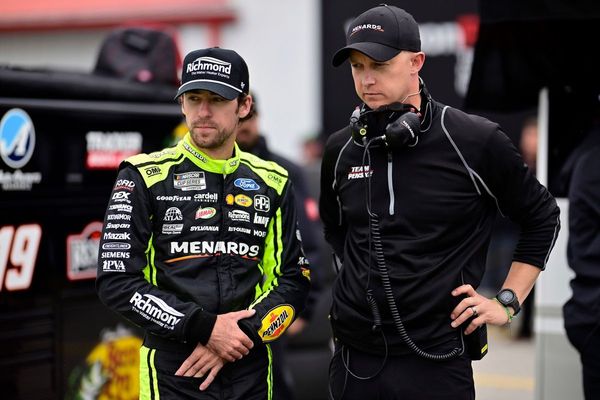
When Eric Gonzaba came out as gay in the 2000s, his family and friends were accepting. He was grateful for the support, but it was still an isolating experience being a queer teen in a small rural town. “I always thought that I was alone, being the only gay person in Harrison county, Indiana,” he said. So he was nervous the first time he wore a rainbow flag T-shirt around his college campus at Indiana University. He still remembers how it felt.
“It was a symbol that I was comfortable being myself,” Gonzaba said.
Gonzaba thinks about T-shirts a lot. He’s not exactly a collector, but he does have an “obsession” with how queer people express themselves with the shirts they wear. “T-shirts don’t tell you the full story of a person’s life, but it’s an exciting launching off-point,” he said. “What did this shirt mean to the person who wore it?”
Gonzaba, a professor of American studies at California State University, Fullerton, began cataloguing T-shirts online at Wearing Gay History in 2014. Since then, he’s archived over 4,500 shirts. He finds the pieces at queer archives around the world, sifting through mothballed boxes to photograph every shirt in the collections. He puts the shirts on his mannequins, snaps a picture, and moves on to the next. The photos are uploaded to his website.

When Gonzaba began archiving shirts, he thought most of the pieces would come from gay capitals like New York or San Francisco, and would mostly entail the expected Harvey Milk memorial shirts and Keith Haring illustrations.
But at the first archive he visited, in Indianapolis, he opened a box filled with tops advertising gay bars or bowling leagues. “It changed how I view my own community,” he said. “These people were not shy about their sexuality, and they were literally wearing their gayness on their sleeves.”
Today, Gonzaba’s archive includes tops from gay rodeos in Reno, Nevada, lesbian bars in Houston, Texas, and trans student groups in Murfreesboro, Tennessee, and Johannesburg, South Africa.
“Queer culture exists in all places,” Gonzaba said. “When I started this project, people told me that I’d find most of my T-shirts in New York, because that’s where the gay movement happened. That really annoyed me. It was such a slap in the face to other places.”

The oldest artifact, a faded white baseball T-shirt from Yale University, hails from the year 1940. It was owned by Loring Hayden, a drag artist popular in Florida’s gay scene during the mid-20th century. There’s nothing “gay” about the shirt itself, but Gonzaba included it given its owner.
The collection picks up in the late 1960s, as student activists began to make T-shirts about gay liberation. After the Stonewall uprising in 1969 and the first Pride marches a year later, more people began to produce tops related to various actions and events.
Gonzaba notes a convenient overlap between the early gay rights movements and the popularity of screen printing in the 1970s. “When people realized you could make T-shirts inexpensively for anything, you see a huge number of them pop up in the 70s and 80s,” he said. “And when people couldn’t print anything, they hand-wrote on tops with markers.”

T-shirt logos reveal how queer communities expressed themselves, such as one from the Gay Asian Pacific Alliance emblazoned with the phrase “Lavender Godzilla”. Or another made in Minneapolis that says “Every time a Republican dies, a queer angel gets their wings”. Or the parody “Lesbiana Jones and the U-Haul of Doom”, a riff on the stereotype that lesbian couples move in together shortly after they meet.
Others are more subtle, referencing queer spaces or jokes one needed to be in on to understand.
“A lot of the T-shirts were not made to be understood by a wider community,” Gonzaba explained. “In the 1950s through the 70s, coming out meant coming out to fellow queer people, not the straight community. The term has morphed over time, but early T-shirts are examples of coming into your community rather than giving an in-your-face statement to the rest of the world.”

T-shirts created for specific events humanize historic moments, such as one from an Indianapolis lesbian bar that hosted a watch party when Ellen DeGeneres came out on primetime television in 1997. (Apparently, Aesop’s Tables was “the ONLY place to be for this blessed event”.)
But there are gaps in the archive: according to Gonzaba, T-shirts reflecting the trans experience make up less than 1% of the garments. “As much as trans people are an important part of our culture and history, our archive doesn’t reflect that,” he said.
A T-shirt from the 1993 March on Washington for “lesbian, gay, and bi equal rights and liberation” noticeably excludes trans people; the rally’s steering committee voted against including them on their merch. Police estimate that 1 million people may have attended the rally, one of the largest in American history.
“That shirt tell you of an uneasiness among activists to allow trans people to have a label during that march,” Gonzaba said. “It doesn’t mean trans people didn’t show up, or didn’t wear the T-shirt. Some of them may have made their own. I noticed during the next major national march, in 2000, it was called the ‘Millennium March’, and had a rainbow on the top, which avoided another controversy.”

One of Gonzaba’s favorite T-shirts in the collection is a plain white top made by an Indiana University student in 2002. The creator used a black marker to write the full names of the “27+” trans people murdered that year.
“It was really important for this single person to honor these people and want others to know about this issue, 20 years ago,” he said. “And, again, this shirt did not come from San Francisco or liberal Massachusetts. It’s a perfect encapsulation of what this project is about: paying attention to all types of queer people, not just the ones who live in relatively safe havens.”

There are also anti-gay tops included in the archive, like one from Syracuse in the early 1990s that reads “Homophobic and proud of it! It’s an exit, not an entrance”. Gonzaba believes it’s important to show how all groups – even the hateful ones – used T-shirts to communicate their messages.

“We don’t have many shirts that are homophobic, but it is important to document T-shirts as walking billboards,” he said. “Just as people wore pride on their sleeves, people wore their homophobia, too.”
Activists responded to homophobia through their T-shirts, too. One faded canary-yellow top in the collection disses Anita Bryant, the singer and brand ambassador for the Florida citrus industry, who in the 1970s took part in a crusade against gay rights. Gay bars across the country boycotted orange juice in protest. That meant screwdrivers were out and “Anita Bryant cocktails”, which swapped OJ for apple juice, were in. And they sold merch, including a top featured in the archive that reads “Anita Bryant sucks oranges”.
Gonzaba will visit collections in New York and Boston this summer to add about 100 more T-shirts to the collection. As long as a T-shirt has a connection to a queer person, he will include it in the archive.

“If there’s a Pride shirt that comes out tomorrow, I’ll photograph it,” he said. “History to me is anything that’s older than today.”
• This article was amended on 31 March 2023. Eric Gonzaba is a professor at California State University, Fullerton, not the University of California as an earlier version said.







